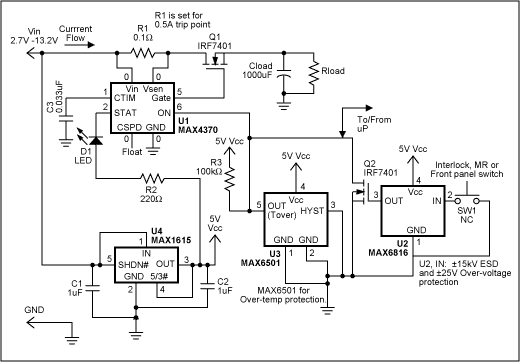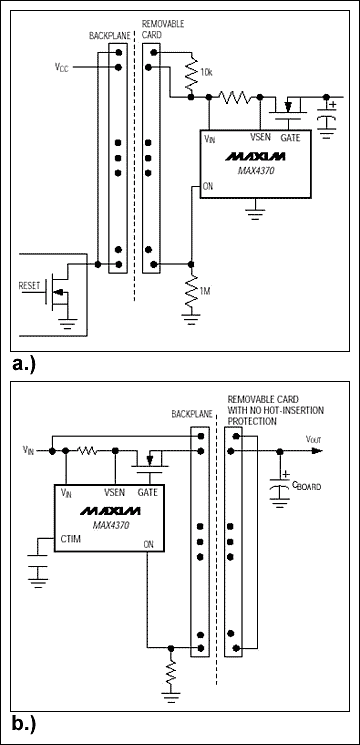

Handy Circuit Gives Systems Fl
通信设计应用
65人已加入
描述
Abstract: When it is necessary to plug in a board into a system that is currently powered, it is critical to control the inrush current to prevent damage/system fault conditions. This application provides a simple circuit to achieve this function as well as an easy method for resetting the system and monitoring against temperature issues.
Many applications must be able to automatically disconnect power from an operating circuit. Such applications include thermal shutdown of high-voltage power supplies in radar and X-ray systems, shutdown to limit inrush current during power-up or hot-swapping of plug-in circuits, and shutdown to ensure that a card is properly seated before power is applied. In general, power should remain off following any system fault.
Figure 1 is a flexible circuit that limits current or removes power in response to a command from the user, or other fault-indicating signal. It accommodates manual-reset (MR), over-temperature, and interlock-switch inputs.

Figure 1. This circuit provides general over-current and over-temperature protection.
U1, for instance, is a circuit-breaker IC designed to offer protection in hot-swap applications. Residing on either the backplane/host side or the removable-card/remote-device side of the backplane connectors, it guards against start-up faults when a card or board is inserted into a rack or host with the main power supply turned on.
Two main fault conditions are possible. Discharged filter capacitors on the card or remote device can provide a low impedance to ground that momentarily collapses the host power supply. Or, a card only partially seated in its connector can generate erroneous data. U1 prevents the first condition by regulating inrush current during a programmable start-up period, allowing the system to stabilize safely. During normal operation, two internal comparators provide short-circuit and over-current protection (DualSpeed/BiLevel capability). The second condition is handled by routing U1's current output (ON) through two pins at the outer edges of the card (Figure 2).

Figure 2. To insure properly seated pc cards on the backplane's card side (a) or host side (b), this IC (MAX4370) routes current through the outer pins of the card connector.
An internal charge pump generates controlled gate drive for an external n-channel MOSFET power switch (Q1). Following a fault condition, U1 latches Q1 off until cleared by an external-reset signal. To indicate fault conditions, connect an LED (or other fault indicator such as an audible alarm) to U1's open-drain status output (STAT). After a fault is detected, you can reset U1 by pulsing its ON pin low for 20mS minimum.
The switch debouncer (U2) has inputs protected to ±15kV for ESD and to ±25V for circuit faults. Its input (shown connected to a normally-closed pushbutton switch) can clear a fault on U1 or provide a manual reset. An internal pull-up to Vcc eliminates the need for an external pull-up resistor. Replacing the pushbutton switch with an interlock or SPST switch provides a power-disconnect signal, which can implement a chassis-intrusion interlock, or allow a technician to power-down the unit before swapping circuit cards. Because U2's push-pull output cannot be directly OR-connected with other signals connected to U1's ON pin, Q2 is added to create an OR-able open-drain connection.
A temperature switch (U3) adds thermal protection, and its open-drain output can be connected either directly (wire-OR'd) to other signals on U1's ON pin, or separately, back to the microprocessor. With its TO220 package option, U3 can be bolted to a heat sink, or surface-mounted (SOT23 option) close to known heat-generating sources such as R1, Q1, or the main load. In this circuit U3 provides circuit protection by issuing a power-disconnect signal when the circuit temperature becomes critical. A low-power linear regulator (U4) provides 5V to the low-voltage components U2 and U3, but U4 is not meant to provide system power to the load.
打开APP阅读更多精彩内容
Many applications must be able to automatically disconnect power from an operating circuit. Such applications include thermal shutdown of high-voltage power supplies in radar and X-ray systems, shutdown to limit inrush current during power-up or hot-swapping of plug-in circuits, and shutdown to ensure that a card is properly seated before power is applied. In general, power should remain off following any system fault.
Figure 1 is a flexible circuit that limits current or removes power in response to a command from the user, or other fault-indicating signal. It accommodates manual-reset (MR), over-temperature, and interlock-switch inputs.

Figure 1. This circuit provides general over-current and over-temperature protection.
U1, for instance, is a circuit-breaker IC designed to offer protection in hot-swap applications. Residing on either the backplane/host side or the removable-card/remote-device side of the backplane connectors, it guards against start-up faults when a card or board is inserted into a rack or host with the main power supply turned on.
Two main fault conditions are possible. Discharged filter capacitors on the card or remote device can provide a low impedance to ground that momentarily collapses the host power supply. Or, a card only partially seated in its connector can generate erroneous data. U1 prevents the first condition by regulating inrush current during a programmable start-up period, allowing the system to stabilize safely. During normal operation, two internal comparators provide short-circuit and over-current protection (DualSpeed/BiLevel capability). The second condition is handled by routing U1's current output (ON) through two pins at the outer edges of the card (Figure 2).

Figure 2. To insure properly seated pc cards on the backplane's card side (a) or host side (b), this IC (MAX4370) routes current through the outer pins of the card connector.
An internal charge pump generates controlled gate drive for an external n-channel MOSFET power switch (Q1). Following a fault condition, U1 latches Q1 off until cleared by an external-reset signal. To indicate fault conditions, connect an LED (or other fault indicator such as an audible alarm) to U1's open-drain status output (STAT). After a fault is detected, you can reset U1 by pulsing its ON pin low for 20mS minimum.
The switch debouncer (U2) has inputs protected to ±15kV for ESD and to ±25V for circuit faults. Its input (shown connected to a normally-closed pushbutton switch) can clear a fault on U1 or provide a manual reset. An internal pull-up to Vcc eliminates the need for an external pull-up resistor. Replacing the pushbutton switch with an interlock or SPST switch provides a power-disconnect signal, which can implement a chassis-intrusion interlock, or allow a technician to power-down the unit before swapping circuit cards. Because U2's push-pull output cannot be directly OR-connected with other signals connected to U1's ON pin, Q2 is added to create an OR-able open-drain connection.
A temperature switch (U3) adds thermal protection, and its open-drain output can be connected either directly (wire-OR'd) to other signals on U1's ON pin, or separately, back to the microprocessor. With its TO220 package option, U3 can be bolted to a heat sink, or surface-mounted (SOT23 option) close to known heat-generating sources such as R1, Q1, or the main load. In this circuit U3 provides circuit protection by issuing a power-disconnect signal when the circuit temperature becomes critical. A low-power linear regulator (U4) provides 5V to the low-voltage components U2 and U3, but U4 is not meant to provide system power to the load.
声明:本文内容及配图由入驻作者撰写或者入驻合作网站授权转载。文章观点仅代表作者本人,不代表电子发烧友网立场。文章及其配图仅供工程师学习之用,如有内容侵权或者其他违规问题,请联系本站处理。
举报投诉
-
Bi-directional level shifter for I2C-bus and other systems.2009-05-12 4988
-
Diode Circuit2009-08-20 4561
-
供应静电纺丝设备handy轻便系列2014-12-05 1795
-
请问我是否可以在fl2xp(cy7c6801)上实现ulpi接口?2019-07-03 1216
-
High-Speed Circuit Board Signa2009-02-17 915
-
RS-485/RS-422 Circuit Implemen2009-06-21 837
-
手持给出系统柔性电路故障保护-Handy Circuit G2009-05-06 1135
-
灵活的系统故障保护电路设计--Handy Circuit G2009-06-09 874
-
FL4830方位灯和FL4830强光手电介绍2011-10-07 1983
-
FL软件板卡安装使用流程2016-12-25 763
-
On-chip Starter Circuit for Switched-inductor DC–DC Harvester Systems2017-10-17 817
-
FL net(OPCN 2)接口模块用户手册2022-08-25 628
-
FL77904/FL77944/FL77905 LED直接交流驱动器设计工具使用指南2022-11-14 439
-
FL77904/FL77944/FL77905自填谷计算工具使用指南2022-11-15 433
-
CFP5-FL;SMD卷轴包SOD128FL-1包装信息2024-02-05 426
全部0条评论

快来发表一下你的评论吧 !

